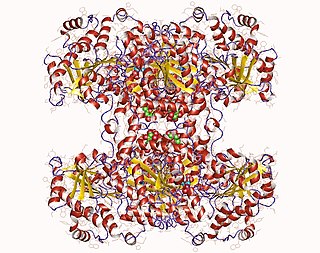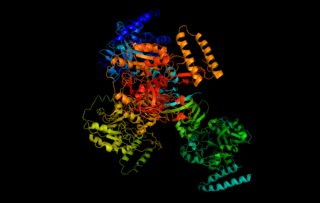
Glycogen is a multibranched polysaccharide of glucose that serves as a form of energy storage in animals, fungi, and bacteria. It is the main storage form of glucose in the human body.
Glycogenesis is the process of glycogen synthesis, in which glucose molecules are added to chains of glycogen for storage. This process is activated during rest periods following the Cori cycle, in the liver, and also activated by insulin in response to high glucose levels.

Glycogen synthase is a key enzyme in glycogenesis, the conversion of glucose into glycogen. It is a glycosyltransferase that catalyses the reaction of UDP-glucose and n to yield UDP and n+1.

The glycogen debranching enzyme, in humans, is the protein encoded by the gene AGL. This enzyme is essential for the breakdown of glycogen, which serves as a store of glucose in the body. It has separate glucosyltransferase and glucosidase activities.

1,4-alpha-glucan-branching enzyme, also known as brancher enzyme or glycogen-branching enzyme is an enzyme that in humans is encoded by the GBE1 gene.
In enzymology, a 1,4-alpha-glucan 6-alpha-glucosyltransferase is an enzyme that catalyzes the chemical reaction that transfers an alpha-D-glucosyl residue in a 1,4-alpha-D-glucan to the primary hydroxyl group of glucose or 1,4-alpha-D-glucan.

UTP—glucose-1-phosphate uridylyltransferase also known as glucose-1-phosphate uridylyltransferase is an enzyme involved in carbohydrate metabolism. It synthesizes UDP-glucose from glucose-1-phosphate and UTP; i.e.,
1,3-Beta-glucan synthase is a glucosyltransferase enzyme involved in the generation of beta-glucan in fungi. It serves as a pharmacological target for antifungal drugs such as caspofungin, anidulafungin, and micafungin, deemed 1,3-Beta-glucan synthase inhibitors. Under the CAZy classification system, fungi and plant members fall in the glycosyltransferase 48 family (GT48). Some members of the glycosyltransferase 2 family, such as the curdlan synthase CrdS, also has a similar activity.
In enzymology, an alpha-1,4-glucan-protein synthase (ADP-forming) is an enzyme that catalyzes the chemical reaction
In enzymology, an alpha,alpha-trehalose-phosphate synthase (UDP-forming) is an enzyme that catalyzes the chemical reaction
In enzymology, a cellulose synthase (GDP-forming) is an enzyme that catalyzes the chemical reaction
In enzymology, a dolichyl-phosphate beta-glucosyltransferase is an enzyme that catalyzes the chemical reaction
In enzymology, a 4-alpha-glucanotransferase is an enzyme that catalyzes a chemical reaction that transfers a segment of a 1,4-alpha-D-glucan to a new position in an acceptor carbohydrate, which may be glucose or a 1,4-alpha-D-glucan.
In enzymology, an indole-3-acetate beta-glucosyltransferase is an enzyme that catalyzes the chemical reaction
In enzymology, a NDP-glucose—starch glucosyltransferase is an enzyme that catalyzes the chemical reaction

In enzymology, a starch synthase is an enzyme that catalyzes the chemical reaction

Sucrose-phosphate synthase (SPS) is a plant enzyme involved in sucrose biosynthesis. Specifically, this enzyme catalyzes the transfer of a hexosyl group from uridine diphosphate glucose (UDP-glucose) to D-fructose 6-phosphate to form UDP and D-sucrose-6-phosphate. This reversible step acts as the key regulatory control point in sucrose biosynthesis, and is an excellent example of various key enzyme regulation strategies such as allosteric control and reversible phosphorylation.

In enzymology, a sucrose synthase is an enzyme that catalyzes the chemical reaction

Glycogenin-1 is an enzyme that is involved in the biosynthesis of glycogen. It is capable of self-glucosylation, forming an oligosaccharide primer that serves as a substrate for glycogen synthase. This is done through an inter-subunit mechanism. It also plays a role in glycogen metabolism regulation. Recombinant human glycogenin-1 was expressed in E. coli and purified using conventional chromatography techniques.
Glucosyl-3-phosphoglycerate synthase is an enzyme with systematic name NDP-glucose:3-phospho-D-glycerate 2-alpha-D-glucosyltransferase. This enzyme catalyses the following chemical reaction









